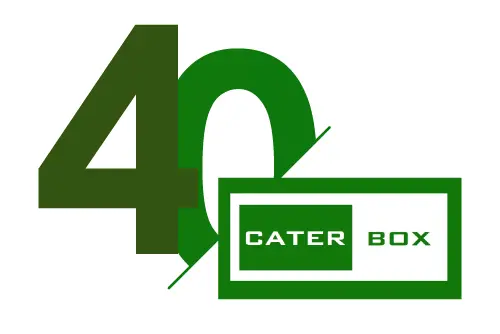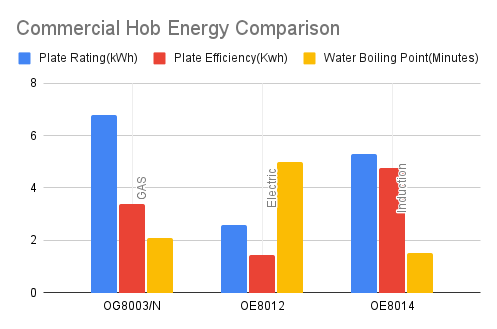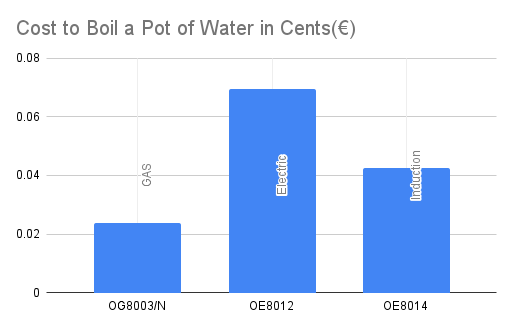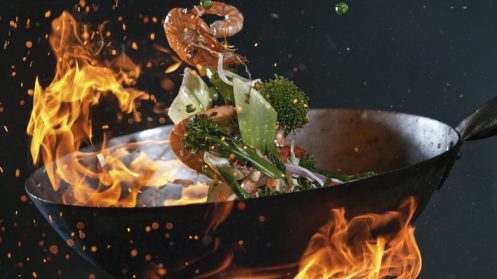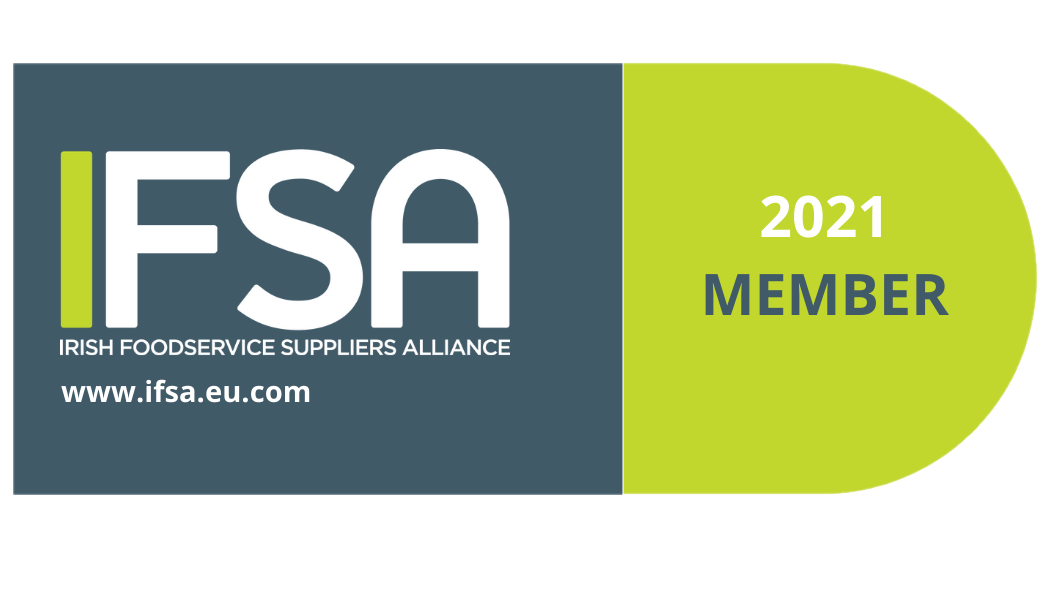
We are now all living in a world where the environmental impact of carbon-based fuels is hard to ignore. Along with this, energy costs are also increasing at an exponential rate. I think we are all trying to find more energy-efficient ways of keeping our homes warm, commuting to and from work, and in business the running costs of equipment.
When it comes to catering equipment there can be huge costs when it comes to energy, both environmentally and financially. What I want to do here is try and outline where the biggest savings can be made when it comes to energy saving and your commercial catering equipment.
GAS Ranges & Hobs
For a lot of us, there is an inherent love of cooking with an open flame and this is why GAS is such a popular choice for cooking, especially with burner hobs and wok cookers. There are clear advantages to cooking with gas which include its low cost(still), instant heat, and precise temperature regulation that the electric versions do not do as well. However, with the onset of Induction technology, there is now a real alternative to GAS.
- Induction wins hands down when it comes to Energy Efficiency and Sustainability, no contest. GAS is hugely inefficient, only 50% of its power is absorbed into the cooking process. The induction will use over 90% of its energy.
- An induction hob will also boil water up to 50% faster than its equivalent in gas. (See Graph)
The above chart shows a comparison between the OPUS range of hobs in GAS, Electric, and Induction.
- Regarding temperature regulation, the induction system wins again. Generally, induction systems have a larger range of temperatures where they can hold higher cooking temperatures and slower simmer temperatures than their GAS equivalent. The temperature is also controlled by a precise electronic thermostat which adjusts the heat instantly.
- However, even with these energy savings, GAS is still the cheaper option. But the induction is a hell of a lot closer than the traditional electric hobs when it comes to cost savings. (See Graph)
Hobs in Conclusion
Along with the above, induction also has many more advantages to GAS, it uses 45% less energy, the surface of the hob does not heat up making your kitchen a cooler place to work in, and it is way easier to clean than a gas hob.
There is one thing however that can not yet be replicated by the induction system, and that is kissing the food with the flame. This can be pretty important for taste. So for a lot of us, it is something that can not be forgotten. Your kitchen might still require the GAS hob for this function. Another option would be a flame torch to light the pan.
In conclusion, the GAS Hob is still the cheapest to run, but it has the lowest energy efficiency by far.
Fryers
The number one energy-saving optimization for a fryer is purchasing a model with an Electronic Thermostat. I have already blogged extensively on this one a while back so maybe have a read through Mechanical or Electronic Thermostat?
What I failed to really emphasize in the blog was the energy-saving characteristics of electronic thermostats. Electronic thermostat accuracy ensures the element spends less time activated. This in turn also reduces energy usage.
It is possible to purchase both GAS and Electric fryers with electronic thermostats, but the electric models will generally have way more energy efficiency.
The most sustainable/cost-effective models would be the Electric version with an Electronic thermostat like the FriFri Range
Again if we are talking brass tacks here, your best option for a fryer is an Energy Optimized GAS model with Electronic Thermostat like the Vortech GAS Fryer.
Contact Griddles
Chrome Plated Griddles have more efficient heat transfer into the food so the energy wasted is significantly reduced. You will notice this because the surrounding space will also be at a significantly lower temperature than conventional steel griddles. Also pay close attention to the plate thickness, the thicker the plate the better the heat retention.
The most sustainable/cost-effective models would be the Electric version with an Electronic thermostat and Chrome Plate like the Mareno Contract Griddle
For brass tacks alone, your option for a Griddle Plate is Chrome Plated GAS model like the Mareno GAS Chrome Griddle
Convection/Combi Ovens
The most popular type of oven in a commercial kitchen is by far the Combi Oven or Steam convection Oven. You can pay anything from €1,000 to €20,000 for the same-sized Steam Convection Oven. Why is this??
So I don’t want to harp on too much about the thermostats but this is again a big energy saver. The more expensive models generally have electronic thermostats. Another thing you will find in the high-end combi ovens is they have intelligent energy systems. This ensures that the oven optimizes and controls the energy output, based on the quantity and type of product, maintaining the best cooking temperature and avoiding fluctuations.
Generally, unless you do not have the option, it is recommended to go electric on your Combi Oven. The best option for low energy consumption would be the Lainox Range
Refrigeration
So when it comes to commercial refrigeration it can be quite difficult to find a fridge or freezer with an energy rating of A or above. As a rule of thumb, any unit with a rating of B or more is considered highly efficient.
Another good tip is to buy fridges with glass doors. This reduces the amount of time a fridge door is open for adding and removing stock. Which reduces the temperature fluctuating, which reduces the amount of energy used.
A good option for a low-energy commercial fridge would be the Gram Glass Door Refrigerator
Although the solid door version has a better energy rating in theory because of the better insulation, in practice the opening and closing of the door will negate this.
5 Year Period
It is prudent to assess the cost of your energy-saving catering equipment with the inclusion of the running cost, and carbon footprint, over 5 years.
For example, if you spend €100k on a new kitchen fit-out, and the annual energy cost is €30k, you will spend €250k in 5 years overall. However, if you spend €120k and invest in energy optimization, your energy cost could be €18k per annum, you will then spend €210k in 5 years overall. This gives you a saving of €40k.
I have mentioned this before and it’s worth mentioning again, the old proverb ‘money breeds money is alive’ and well and there is no denying this. If your budget is large and plentiful you will ultimately save energy and money over the five-year period.
Power Guardian
Catering Equipment Manufacturers Mareno has developed, and now offers, a new power surge control system which was created to control large-scale electrical cooking appliances, this system achieves electricity savings of over 43%. The Power Guardian® system lets the user control and reduces electricity consumption, therefore providing real savings and it guarantees that installed power remains within established parameters. This is a real option for kitchens looking to use, or replace five or more cooking appliances. please email info@caterbox.ie if you would like some more information on this.
Summary
Prior to writing this blog, I had wrongly made the assumption that Induction was the cheapest, followed by GAS, then Standard Electric. It was also to my surprise that I found GAS was the cheapest.
I had made the mistake of directly comparing the ‘energy efficiency to the ‘fuel cost’. I failed to account for the low cost of GAS compared to electricity.
So in conclusion, if you are solely out to cut your bills, then GAS with Energy Optimization Features is the job. But if you are also considering the environment and want to use more clean energy then it’s induction for you. Induction works while still keeping your bills low.
Whichever way you go I wish you the best of luck in all your future endeavors.
Gary
Managing Director
Caterbox Ireland
